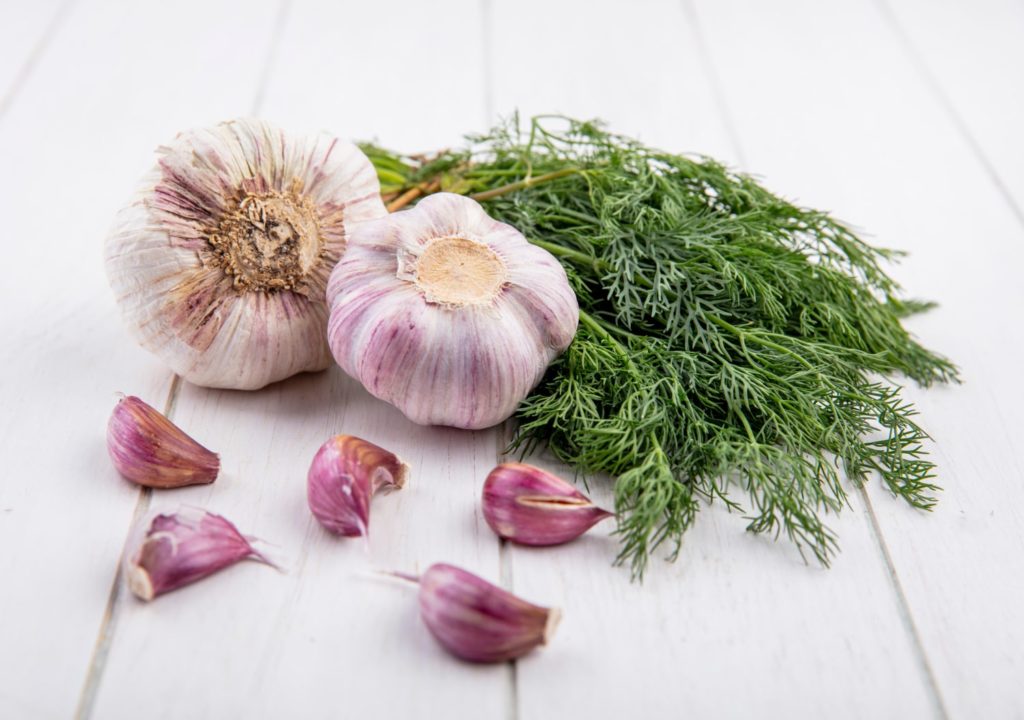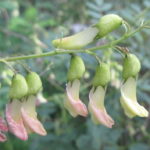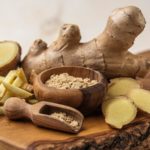
Megan Rodden
(BCS, DipNat, MedHerb, NMHNZ)
Garlic is a versatile food and natural medicine with a wide range of health benefits thanks to its potent anti-oxidant and anti-microbial properties.
Garlic has been shown to help:
- Reduce inflammation and oxidative stress
- Support immune function
- Lower high blood pressure
- Assist with hyperlipidemia
- Assist with non-alcoholic fatty liver disease
Garlic’s broad anti-microbial effects can also help combat infections, making it a valuable remedy, which we discuss in more detail in the article.
Introduction
Garlic is a very familiar household herb, used in everyday cooking for its intense flavour and loved by many as a remedy for colds and flu.
Garlic is a versatile herb with a long history of medicinal use that dates back to antiquity. Before the advent of anti-biotics garlic was used around the world during many major illness outbreaks and epidemics and is mentioned in many historical medical texts, including the works of Hippocrates.
The earliest recorded use of garlic is from Ancient Egyptian medical texts, the Codex Ebers, dated 1550BC, where it was used to successfully treat tumours.[1]
Other Names
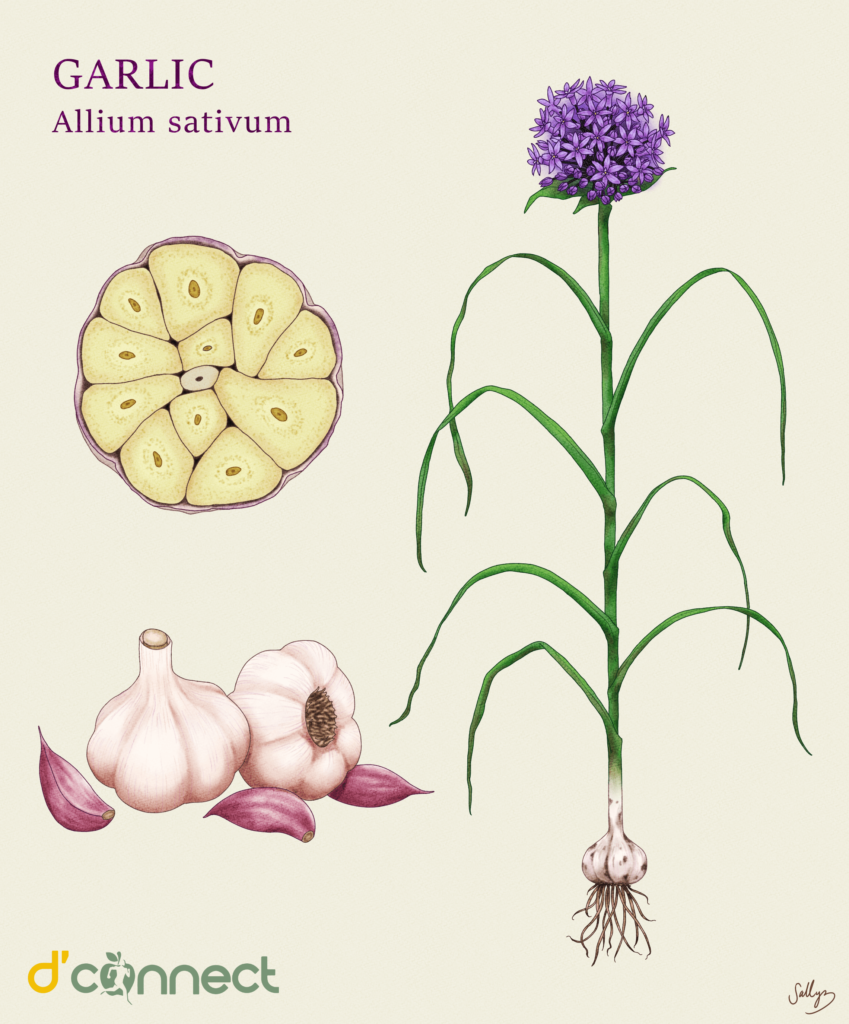
Botanical name: Allium sativum.
Common name: Garlic.
Family: Liliaceae.
Additional names: Allium, camphor of the poor, rustic treacle, stinking rose, da-suan kno-blauch.
The name Garlic comes from the word garleac, which is an Anglo-Saxon word that means spear leak.
Characteristics
Garlic is a perennial bulb containing several individual cloves that can be used to seed a new plant. Garlic has small slightly pink and white flowers with long flat leaves that wrap around the base of the plant.
Garlic is known for its distinctive pungent odour and acrid taste when eaten raw.[2]
Use
The cloves within the garlic bulb are the most commonly used part. The papery skin is removed and the clove is consumed raw, cooked or as garlic oil or powder extract.
The cloves are the most commonly used part of garlic
The cloves are also often chopped or crushed and used to flavour meals such as soups or stews.
Traditional use
Historically garlic has been used around the world for a wide variety of health conditions, such as:
- bacterial and viral infections (typhoid, cholera and diphtheria)
- haemorrhoids
- epilepsy
and was often referred to as a “heal all” herb.[3]
Medicinal Use
In more modern times garlic has been studied as an effective treatment for a variety of conditions including:
- Bacterial infections
- Fungal infections
- Viral infections
- Atherosclerosis
- Hypertension
- Hyperlipidemia
- Periodontitis
- Endometriosis
- Non-Alcoholic Fatty Liver Disease[4]
Nutritional facts
Garlic is a source of:
and contains minerals such as:
Health benefits
The health benefits of garlic are attributed to a complex interplay of its bio-active compounds, particularly its three sulphur compounds alliin, allicin and garlicin.
Garlic also contains anti-oxidants of note that are known to protect the liver. These are apigenin, myricetin and quercetin.
When garlic is crushed or chopped, the enzyme allinase converts alliin into allicin, a powerful compound known for its anti-oxidant, anti-inflammatory and anti-microbial properties.[5]
Garlic and cardiovascular health
Studies show that garlic extracts may support cardiovascular health by:
- reducing blood pressure
- lowering cholesterol levels
- improving circulation[5]
One study looked at the effect of an aged garlic extract on blood pressure with results showing a significant decrease in both systolic and diastolic pressure and improvement in arterial elasticity.[6]
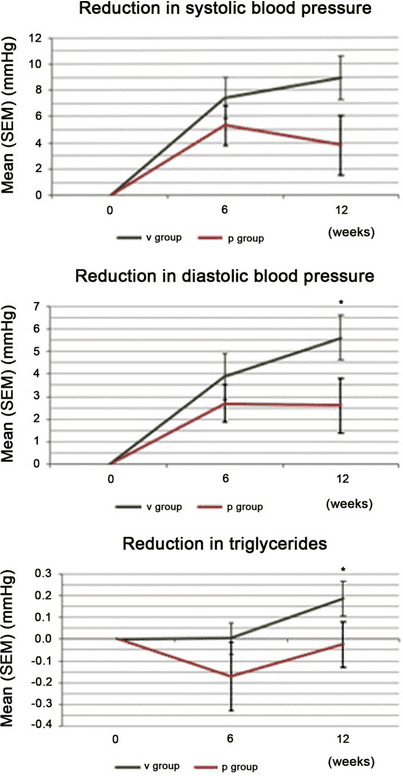
Garlic and immune system health
The extensive antimicrobial properties of garlic make it an ideal herb to support the immune system against viral, fungal and bacterial infections.
In vitro studies have found garlic extracts to be effective against a number of infectious microbes, including anti-biotic resistant bacteria.[4,7,8]
For example, one in vitro study showed significant anti-bacterial activity from garlic against streptomycin resistant strains of bacteria, Staphylococcus aureus ATCC BAA 1026 and gram-negative Escherichia coli ATCC 10536, alone, and the potential to prevent resistance when used together with streptomycin.[9]
The anti-biotic resistant bacteria tested cause common infections like pneumonia and infections of the gut and urinary tract.
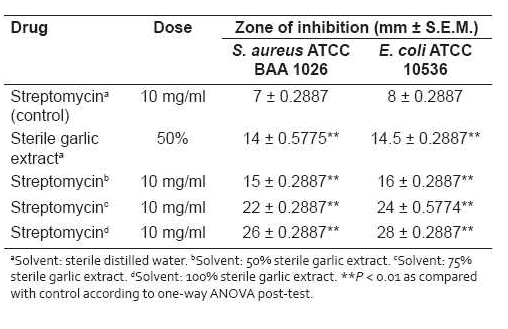
One clinical trial found significant reductions in Streptococcus mutans, Lactobacilli species, and Candida albicans in the mouths of 45 children, aged 4 to 6 years, with dental caries after the use of a mouth wash with garlic and lime.[10]
Another study showed treating children with a long releasing garlic tablet was both safe and effective in preventing acute respiratory diseases.
172 children were given 600mg garlic tablets per day for five months resulting in diminished acute respiratory diseases morbidity 2–4-fold at the first stage and 1.7-fold at the second stage compared to the controls, as a consequent inhibition of infection.[11]
Garlic and gastrointestinal health
Garlic has also been shown to have a positive and protective effect on gut health and gastric diseases. Garlic contains beneficial compounds including a pre-biotic, and garlic fructans have been studied for its positive effect on beneficial gut bacteria.[12]
Garlic may be useful in the prevention of gastric conditions, highlighted in the following study results:
- Reduced incidence of gastric cancer with long-term intake of garlic supplements and garlic plus vitamin supplementation, in patients treated for H.pylori[13]
- A decreased appearance of precancerous gastric lesions or gastric cancer with long-term supplementation with garlic and increased results with lifestyle factors, such as alcohol avoidance[14]
- Reduced rates of oesophageal and stomach cancer with weekly consumption of garlic within a high incidence population in China[15]
Garlic has strong anti-bacterial properties
Garlic has been shown to promote the growth of beneficial gut bacteria while inhibiting harmful pathogens, such as Clostridium difficile and E. coli.
Garlic may also reduce intestinal inflammation, a key factor in conditions like irritable bowel syndrome and inflammatory bowel disease.[16]
Garlic and non-alcoholic fatty liver disease
Garlic may be helpful in supporting people with Non-Alcoholic Fatty Liver Disease (NAFLD).
The results of four studies with 186 patients with NAFLD found that taking 800-1600mg of garlic powder daily may reduce aspartate aminotransferase (AST) and alanine transaminase (ALT), which are markers of the disease and lower the probability of hepatic steatosis (excess liver fat) by 2.75 times when compared with placebo.[17]
One of these studies saw significant improvement in markers of 110 people with NAFLD, including lab results and ultrasound after 12 weeks of treatment with garlic.[18]
Garlic and fungal infections
Garlic has been shown to be an effective topical treatment for fungal infections. One study resulted in a rapid improvement of signs and symptoms of infection with tinea pedis with topical treatment using a garlic extract, ajoene.[19]
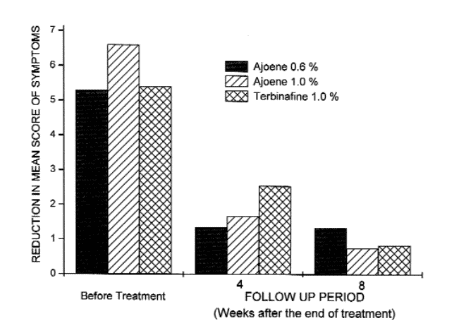
A further similar study found that treatment of tinea pedis with ajoene as a 0.4% cream resulted in complete cure in 27 of 34 patients (79%) after seven days of treatment. The remaining seven patients (21%) achieved complete cure after seven additional days of treatment.[20]
Another study compared the antifungal effect of garlic extract mouthwash with standard treatment (nystatin) for denture stomatitis with Candida Albicans infection. Garlic resulted in significantly improved symptoms with fewer side effects than nystatin.[21]
Therapeutic dosage
Fresh garlic: 2-5g per day, bruised or crushed.
Dried garlic powder: 0.4-1.2g per day.
Garlic oil: 2-5mg per day.
Fluid extract (1:1): 0.5-2ml three times daily.[22]
Safety concerns
Garlic may not be safe at therapeutic levels during pregnancy, especially during the first trimester, however standard dietary amounts are considered generally safe.[23]
Garlic should be taken with a meal to prevent any unwanted gastro-intestinal problems such as heartburn or bad breath.
It is best to avoid raw garlic directly on skin as it may cause burns.[2]
Possible interactions with medications
Therapeutic doses of garlic may interact with a number of medications:
- Anti-coagulants and anti-platelets – in theory garlic may interact with anti-coagulants as garlic may have similar anti-platelet properties.
- Anti-hypertensives – a possible additive interaction may occur due to the anti-hypotensive properties of garlic.
- Anti-hyperlipidaemic agents – garlic may have a beneficial interaction adding to the positive effects of these agents.
- H.pylori triple therapy – beneficial interactions are possible due to additive effects of garlic.
- Warfarin, Saquinavir, Ritonavir – garlic may interact with these medications altering its effectiveness.[4,22,24]
Possible interactions with herbs and supplements
Theoretically garlic may interact with herbs and supplements with similar actions including: anticoagulant/antiplatelet, antihypoglycemic, and antihypertensive.
For example:
have similar actions, however, no significant interactions have been reported with herbs or supplements and garlic.
Summary
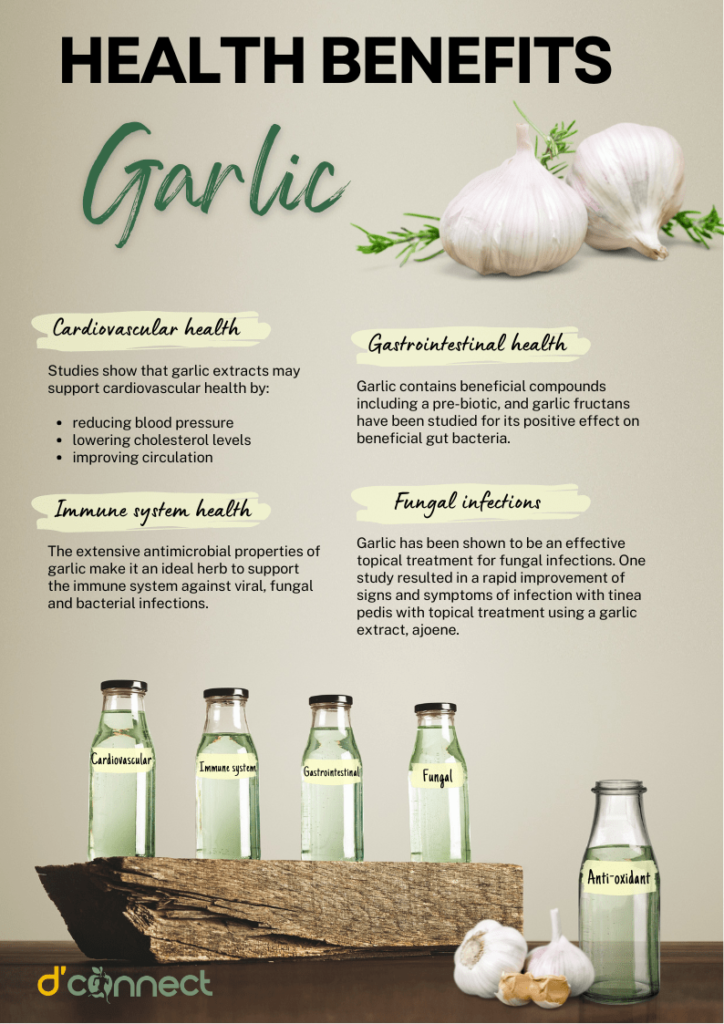
Note — feel free to share or download this illustration.
Related Questions
1. What is the best time to take garlic as a supplement?
Garlic can be taken at any time of the day and the best time may depend on your tolerance and personal preference.
For example, you may find it easiest to take garlic supplements in the morning with a meal to avoid any stomach discomfort. The most important factor is to take it consistently to ensure you get the full benefits.
2. Is it safe to supplement with garlic long term?
Garlic is generally well tolerated and has been safely used in many clinical studies spanning up to seven years with no reports of serious side effects or toxicity.
Chronic conditions may benefit from longer treatment, but it is always best to consult with your naturopath or herbalist to ensure the right dosage and duration of treatment for you.
3. How much garlic should I eat daily to have the same benefits when supplementing?
For general health maintenance you can consume 2-5 grams of fresh garlic daily.
For active infections, 2-6 cloves of fresh garlic is usually taken per day.
Garlic must be crushed and bruised before it is consumed to activate the therapeutic properties. Cloves can be added to food, however, ensure that the cloves are fresh and remain uncooked to prevent loss of active constituents.[2]
Megan helps her clients to rebalance their bodies through holistic nutrition, herbal medicine and a naturopathic lifestyle. Her personal health journey transitioned her from a communications consultant to a naturopath, sparked by struggles with chronic health issues, particularly after having children and finding vital support from natural therapies…
If you would like to learn more about Megan, see Expert: Megan Rodden.
References
(1) Hassan, HT. (2004). Ajoene (natural garlic compound): a new anti-leukemia agent for AML therapy. Leuk Res. 28.7: 666-671.
(2) Fisher, C. (2009). Materia Medica of Western Herbs. Vitex Medica.
(3) Petrovska, BB., Cekovska, S. (2010). Extracts from the history and medical properties of garlic. Pharmacogn Rev. Jan;4(7):106-10. doi: 10.4103/0973-7847.65321. PMID: 22228949; PMCID: PMC3249897. https://pmc.ncbi.nlm.nih.gov/articles/PMC3249897/
(4) Natural Medicines Database. (2024). Garlic, professional monograph. Therapeutic Research Centre.
(5) Harunobu, A., Brenda, L., Petesch, Matsuura, H. Kasuga, S., Yoichi Itakura. (2001). Intake of garlic and its bio-active components. The Journal of Nutrition. https://doi.org/10.1093/jn/131.3.955S
(6) Gruenwald, J,. Bongartz, U,. Bothe, G,. Uebelhack, R. (2020). Effects of aged garlic extract on arterial elasticity in a placebo-controlled clinical trial using EndoPAT™ technology. Exp Ther Med. Feb;19(2):1490-1499. doi:10.3892/etm.2019.8378. Epub 2019 Dec 27. PMID: 32010328; PMCID: PMC6966200.
(7) Uzun, L,. Dal, T,. Kalcıoğlu, MT,. Yürek, M,. Açıkgöz, ZC,. Durmaz, R. (2019). Anti-microbial Activity of Garlic Derivatives on Common Causative Micro-organisms of the External Ear Canal and Chronic Middle Ear Infections. Turk Arch Otorhinolaryngol. doi: 10.5152/tao.2019.4413. Epub 2019 Dec 1. PMID: 32128511; PMCID: PMC7032553.
(8) Serrano Gruhlke, H.D.A.; Mariezcurrena-Berasain, M.A.; Castillo, A.D.C.G.; Carranza, B.V.; Pliego, A.B.; Rojas, M.T.; Anele, U.Y.; Salem, A.Z.M.; Rivas-Caceres, R.R. (2020). Anti-microbial resistance of three common molecularly identified pathogenic bacteria to Allium aqueous extracts. Microb. Pathog. 142, 104028.
(9) Palaksha, MN., Ahmed, M., Das, S. (2010). Anti-bacterial activity of garlic extract on streptomycin-resistant Staphylococcus aureus and Escherichia coli solely and in synergism with streptomycin. J Nat Sci Biol Med. Jul;1(1):12-5. doi: 10.4103/0976-9668.71666. PMID: 22096329; PMCID: PMC3217283. https://pmc.ncbi.nlm.nih.gov/articles/PMC3217283/
(10) Thomas, A., Thakur, S., Habib, R. (2017).Comparison of Anti-microbial Efficacy of Green Tea, Garlic with Lime, and Sodium Fluoride Mouth Rinses against Streptococcus mutans, Lactobacilli species, and Candida albicans in Children: A Randomised Double-blind Controlled Clinical Trial. Int J Clin Pediatr Dent. Jul-Sep;10(3):234-239. doi: 10.5005/jp-journals-10005-1442. Epub 2017 Feb 27. PMID: 29104381; PMCID: PMC5661035.
(11) Andrianova, IV., Sobenin, IA., Sereda, EV,, Borodina, LI., Studenikin, MI. (2003). Vliianie chesnochnykh tabletok prolongirovannogo deĭstviia “allikor” na zabolevaemost’ ostrymi respiratornymivirusnymi infektsiiami u deteĭ [Effect of long-acting garlic tablets “allicor” on the incidence of acute respiratory viral infections in children]. Ter Arkh. 2003;75(3):53-6. Russian. PMID: 12718222.
(12) Zhang, N., Huang, X., Zeng, Y., Wu, X., Peng X., (2013). Study on pre-biotic effectiveness of neutral garlic fructan in vitro. Food Science and Human Wellness. Volume 2, Issues 3–4, https://doi.org/10.1016/j.fshw.2013.07.001.
(13) Li, WQ., Zhang, JY., Ma, JL., Li, ZX., Zhang, L., Zhang, Y., Guo, Y., Zhou, T., Li, JY., Shen, L., Liu, WD., Han, ZX., Blot, WJ., Gail, MH., Pan, KF., You, WC. (2019). Effects of Helicobacter pylori treatment and vitamin and garlic supplementation on gastric cancer incidence and mortality: follow-up of a randomised intervention trial. BMJ. Sep 11;366:l5016. doi: 10.1136/bmj.l5016. PMID: 31511230; PMCID: PMC6737461.
(14) Guo, Y., Li, ZX., Zhang, JY., Ma, JL., Zhang, L., Zhang, Y., Zhou, T., Liu, WD., Han, ZX., Li, WQ., Pan, KF., You, WC. (2020). Association Between Lifestyle Factors, Vitamin and Garlic Supplementation, and Gastric Cancer Outcomes: A Secondary Analysis of a Randomised Clinical Trial. JAMA Netw Open. 2020 Jun 1;3(6):e206628. doi: 10.1001/jamanetworkopen.2020.6628. PMID: 32589229; PMCID: PMC7320300.
(15) Gao, CM., Takezaki, T., Ding, JH., Li, MS., Tajima, K. (1999). Protective effect of allium vegetables against both esophageal and stomach cancer: a simultaneous case-referent study of a high-epidemic area in Jiangsu Province, China. Jpn J Cancer Res. 90(6):614-21. doi: 10.1111/j.1349-7006.1999.tb00791.x. PMID: 10429652; PMCID: PMC5926109.
(16) Ansary, J.; Forbes-Hernández, T.Y.; Gil, E.; Cianciosi, D.; Zhang, J.; Elexpuru-Zabaleta, M.; Simal-Gandara, J.; Giampieri, F.; Battino, M. Potential Health Benefit of Garlic Based on Human Intervention Studies: A Brief Overview. Anti-oxidants 2020, 9, 619. https://doi.org/10.3390/antiox9070619
(17) Rastkar, M, Nikniaz L, Abbasalizad Farhangi M, Nikniaz Z. (2022). Systematic review and meta-analysis of the effect of garlic in patients with non-alcoholic fatty liver disease. Indian J Gastroenterol. Dec;41(6):548-557. doi:10.1007/s12664-022-01287-8. Epub 2022 Dec 28. PMID: 36576698.
(18) Sangouni AA, Mohammad Hosseini Azar MR, Alizadeh M. (2020). Effect of garlic powder supplementation on hepatic steatosis, liver enzymes and lipid profile in patients with non-alcoholic fatty liver disease: a double-blind randomised controlled clinical trial. British Journal of Nutrition. ;124(4):450-456. doi:10.1017/S0007114520001403
(19) Ledezma E, Marcano K, Jorquera A, De Sousa L, Padilla M, Pulgar M, Apitz-Castro R. (2000). Efficacy of ajoene in the treatment of tinea pedis: a double-blind and comparative study with terbinafine. J Am Acad Dermatol. Nov;43(5 Pt 1):829-32. doi: 10.1067/mjd.2000.107243. PMID: 11050588. https://www.researchgate.net/publication/12275264_Efficacy_of_ajoene_in_the_treatment_of_tinea_pedis_A_double-blind_and_comparative_study_with_terbinafine
(20) Ledezma, E., DeSousa, L., Jorquera, A., Sanchez, J., Lander, A., Rodriguez, E., Jain, MK., Apitz-Castro, R. (1996). Efficacy of ajoene, an organosulphur derived from garlic, in the short-term therapy of tinea pedis. Mycoses. 39(9-10):393-5. doi: 10.1111/j.1439-0507.1996.tb00160.x. PMID: 9009665.
(21) Bakhshi, M., Taheri, J.-B., Basir Shabestari, S., Tanik, A. and Pahlevan, R. (2012). Comparison of therapeutic effect of aqueous extract of garlic and nystatin mouthwash in denture stomatitis. Gerodontology, 29: e680-e684. https://doi.org/10.1111/j.1741-2358.2011.00544.x
(22) Braun, L., Cohen, M. (2015). Herbs and Natural Supplements, An Evidence Based Guide, Volume 2. Victoria, Australia. Elsevier.
(23) Bloch, AS. Pushing the Envelope of Nutrition Support: Complementary Therapies. Nutrition 2000;16:236-9.DOI: 10.1016/s0899-9007(99)00275-0
(24) Gurley, BJ., Gardner, SF., Hubbard, MA. (2000). Clinical assessment of potential cytochrome P450-mediated herb-drug interactions. AAPS Ann Mtg & Expo Indianapolis, IN: Oct 29 – Nov 2:presentation #3460.

